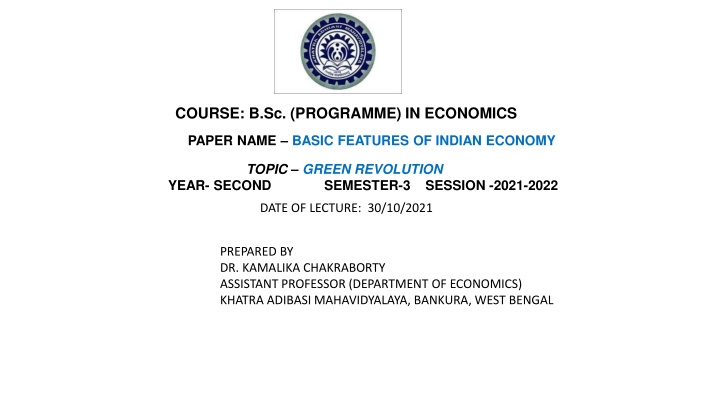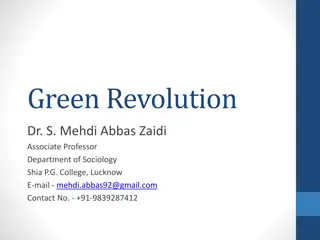
Key Insights on India's Green Revolution in Economics Seminar
Explore the essence of India's Green Revolution, a pivotal technique enhancing agricultural production, through the adoption of high-yielding seeds, fertilizers, pesticides, and modern machinery. Delve into the positive and negative impacts it has had on the economy, including increased production, employment opportunities, and industrial growth alongside challenges like regional imbalance and job displacement. Dr. Kamalika Chakraborty from Khatra Adibasi Mahavidyalaya, Bankura, sheds light on this transformative period in Indian agriculture.
Download Presentation

Please find below an Image/Link to download the presentation.
The content on the website is provided AS IS for your information and personal use only. It may not be sold, licensed, or shared on other websites without obtaining consent from the author. If you encounter any issues during the download, it is possible that the publisher has removed the file from their server.
You are allowed to download the files provided on this website for personal or commercial use, subject to the condition that they are used lawfully. All files are the property of their respective owners.
The content on the website is provided AS IS for your information and personal use only. It may not be sold, licensed, or shared on other websites without obtaining consent from the author.
E N D
Presentation Transcript
COURSE: B.Sc. (PROGRAMME) IN ECONOMICS PAPER NAME BASIC FEATURES OF INDIAN ECONOMY TOPIC GREEN REVOLUTION YEAR- SECOND SEMESTER-3 SESSION -2021-2022 DATE OF LECTURE: 30/10/2021 PREPARED BY DR. KAMALIKA CHAKRABORTY ASSISTANT PROFESSOR (DEPARTMENT OF ECONOMICS) KHATRA ADIBASI MAHAVIDYALAYA, BANKURA, WEST BENGAL
Concept Green revolution is a technique used to improve agricultural production in India in the mid sixties. This technology involves use of high yielding variety(HYV) seeds, use of fertilizers, pesticides and modern machineries. Two crops which benefited most due to the application of this modern technology are rice and wheat.
Features Use of High-Yielding Variety (HYV) seeds Use of various irrigation methods Use of chemical fertilizers Use of pesticides Use of modern machineries like tractors, trailers etc. Practice of multiple cropping.
Positive effects of Green Revolution in India Increased production Increase in employment opportunities Rise in agricultural production Greater availability of food Industrial expansion Reduction in poverty and improvement in standard of living
Negative effects of Green Revolution in India Regional imbalance not all regions of India could apply modern technology in agriculture due to high expenses that were involved with it Production of all crops did not increase due to green revolution Job displacement due to use of machines






















